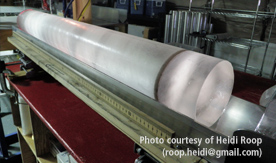
Kreutz, Students Part of Ice Core Team That Links Abrupt Temperature Changes in Arctic, Antarctic
A research team that includes University of Maine scientists announced a 60,000-year-old ice core from West Antarctica reveals that ocean currents redistributed past abrupt temperature changes in the Arctic to the Antarctic, a distance of about 11,000 miles.
In addition to demonstrating a consistent link between previous sudden, rapid temperature changes in the Arctic and Antarctic, the research explains interactions of climate changes in the northern and southern hemispheres.
UMaine climate scientist Karl Kreutz took part in the project, as did then-doctoral students Bess Koffman and Dan Breton, then-master’s student Dominic Winski and undergraduate Honors student Eliza Kane. Christo Buizert from Oregon State University is the lead author of the research paper published in Nature.
The National Science Foundation-funded study shows over the course of about 200 years, ocean currents spread heat from rapid climate changes during the last ice age in the North Atlantic around Greenland to Antarctica.
The climate in Greenland was unstable during the last ice age (approximately 110,000 to 12,000 years ago) with abrupt 40- to 50-degree F temperature changes that lasted from one to five decades each. Temperature changes in Antarctica followed an opposite pattern, with Antarctica cooling when Greenland was warm, and vice versa.
Project participants say understanding how and why climate changed in the past helps scientists predict how Earth’s climate will respond to human-caused increases in greenhouse gases.
The sudden climate changes during the most recent ice age were regional and caused by large-scale changes in ocean circulation triggered by the collapse of ice sheets. Current changes in temperature and precipitation are global and primarily are caused by increasing levels of carbon dioxide in the Earth’s atmosphere, say researchers.
“These new results from the WAIS (West Antarctic Ice Sheet) Divide ice core are really exciting, and represent the culmination of years of work by the U.S. ice core community,” says Kreutz, a paleoclimatologist (studies the Earth’s climate history).
“The WAIS Divide ice core contains a climate record from Antarctica that has a time resolution comparable to Greenland ice cores, allowing direct comparison of abrupt temperature changes in both hemispheres during the last ice age. The finding that these abrupt climate changes started in the North Atlantic near Greenland, and took about 200 years to move to Antarctica, provides a new context for our understanding of the climate system.”
The goal of the research was to determine the relative timing of temperature changes in the Arctic and Antarctic, with a precision of several decades. To achieve this, researchers needed a climate record from the Southern Hemisphere that extended at least 60,000 years into the past and could resolve fast changes in climate.
The research team consists of 28 science and engineering groups from around the United States, including the University of Wisconsin-Madison, Desert Research Institute, University of New Hampshire, the U.S. National Ice Core Laboratory and University of Washington.
The team considered sites all over Antarctica before selecting the one with the best combination of thick ice (11,200 feet), simple ice flow and the right amount of annual snowfall (1.5 feet). Previously drilled ice core records from Greenland provided the detailed history of Arctic temperature change and the new ice core provides the Antarctic record necessary to make a detailed comparison.
The 4.8-inch diameter cylinders of ice that make up the 11,200-foot-long ice core were recovered at a field camp in the center of West Antarctica, 650 miles from the geographic South Pole, called WAIS Divide.
When snow falls at WAIS Divide it rarely melts. Instead, it builds up in thick annual layers, which are compressed into ice by subsequent snowfall. The compacted snow contains dust, chemicals and atmospheric gases, which are trapped in the ice. The dust and other chemicals in the ice are indicators of past climate, and the gas contained in air bubbles is a sample of the ancient atmosphere. The deeper the ice, the older it is, and the farther back in time measurements can be made.
To read the paper, visit, nature.com/nature/journal/v520/n7549/full/nature14401.html.
Photo courtesy of Heidi Roop (roop.heidi@gmail.com)
Contact: Beth Staples, 207.581.3777
